#making textiles
Explore tagged Tumblr posts
Text
So I decided to learn to knit! I've never before found a way to ethically and cheaply get yarn. I found a little ball of yarn outside at some point, as one does, and saved it, but beyond that I didn't have any other tools. Then I saw a video showing how you can take a thrifted machine-knit sweater, and undo it back into yarn, and then just knit with that. Incredible, since I have a full box of old sweaters, I just need to figure out which ones are easily undone.
So I grabbed my little ball of found yarn, and then I needed some needles. I looked up what I could use instead, and found there's plenty of alternatives; pencils, chopsticks, wooden sticks for barbecue. Looking around my room I realized I had some very long paintbrushes; I tried to use them, and immediately realized they need to have a pointy end. I grabbed a pencil sharpener and sharpened them; only this made them very rough and splintered. I needed to sand them down, but I had no sandpaper, and then I remembered that recently someone gave me a flat tool that removes dry skin from feet. I sanded them down with that, and it actually worked, they worked perfectly like knitting needles. They're even the same size.

The knitters probably already know this, but if you start knitting for the first time, especially if it's winter and you're under a blanket, some ancient human instinct will activate and you will feel that you are doing exactly what you're supposed to be doing and everything is well and right with the world. Creating fabric is a powerful thing to do, in a society where everyone needs fabric to stay alive, and go outside, and I like having this power to myself.
I found out there are two basic types of stitches; knit stitch, and purl stitch. I liked the knit stitch better, on the basis that purl stitch had 'bad vibes'.
It knew before that most fabric will be woven, or knitted, or in some cases, crochet, so I got little curious, and studied each layer of clothing on me, and every single item of clothing was knit, and it was all a purl stitch. I got fascinated by this, wondering if this is true for most clothing, or if I just somehow prefer knit things on me because they're nice and stretchy. Looking into other fabrics, I could easily tell that all of the sheets, pillowcases and kitchen cloths were woven, and that they were much sturdier and less stretchy for it.
I looked at stuff in my closet, and found that I had a scarf, hat, and pants that were woven, but in very soft and warm fabric, and they were very sturdy and non-stretchy as well. I then wondered what was the logic behind it, and is there a traditional type of things that will be woven, that isn't just bedsheets and cloths?
I tried to find a video on youtube detailing that stuff, but no female-made video was found, so I'm now downloading several women-written audibooks on the topic of history of textiles. I think we should just take the power to make textiles back to us, because back when women were the maker of the cloth, it was just something we 'did out of the goodness of our hearts for our families' but it was also environmentally friendly, practical, sustainable and a beautiful, powerful craft. Now that m*n decided it's something to make money off, they created fast fashion, tons of waste and environmental damage, new types of slavery for workers, and the clothing isn't even practical anymore, it's made to fall apart.
So, back to my knitting, I have to say it's not happening very fast, I thought by the end of the day I would be done with that little ball of yarn and be able to tell how much fabric it can make, nope, did not happen, in fact I've been working on it two days and by this time I've barely made any progress. Apparently the 'purl stitch' is faster, well, I'm still refusing to do it. Boo purl stitch. The yarn I found outside is some of the worst quality yarn I've ever seen, not only it's different in thickness everywhere, but in some places there are 3-4 different threads distangled from each other, and it confused me so much while knitting that I kept adding stitches on the brush unnecessarily, until the entire thing could barely fit on one.
One thing that surprised me was how incredibly soft, stretchy and comfortable the fabric feels when made. I genuinely expected the fabric to be as horrifying as the yarn quality, nope, it's nice and comfy I absolutely love it.
There is a movement in online spaces for being mindful of environment when purchasing clothing, and making our own wardrobes, which is absolutely delightful; seeing people gain new respect and fascination for clothing, sewing and textile making, and then doing it themselves and becoming non-dependent on capitalism, it's the change the world needs. I didn't think I would try to join in, because I get so much discarded and unwanted clothing from others, I wouldn't need to buy any ever, but I did get fascinated by looms, natural fibers, and women doing all that work, that I can't resist trying it out.
#knitting#making textiles#yarn#learning to make fabrics#making fabrics#craft#history of textile#knits weaving and crochet
120 notes
·
View notes
Text
I finally made my first yarn wig after 10+ years of crocheting my cosplays...
#artist#crochet#crocheting#fiber art#yarn#yarn crafts#cosplay#crochet cosplay#fiber artist#fiber crafts#my crochet#my cosplay#my art#wig#wig making#costume construction#cosplayer#costume#crochet tumblr#crochet wig#marie antoinette#rococo#historical fashion#fibre artist#fibre arts#textile art#textiles#costume design#crochet design#designer
25K notes
·
View notes
Text
no but genuinely I lose a little more patience for people who won't wear wool, leather, silk, or fur every day that I live in a world where plastic is increasingly the only damn kind of clothing you can find (or the only kind of fabric for sewing, even)
obviously, animal cruelty is horrible. I believe that even industries that rely on the deaths of animals should make their lives as good and their ends as humane as possible. and many of these industries need tighter environmental regulations on their production practices- some of the chemicals involved are highly toxic and ill-controlled at times
but at some point, you have to wake up to the fact that the only alternative we've found to date is destroying our planet
it's all plastic. and plastic is horrible for the world- the environment, humans, and especially animals. how cruelty-free is it to cause mass habitat loss? or climate change that disrupts food sources for those animals on a vast scale? how is that better than the deaths of a relatively small proportion of animals comparatively?
(and don't even start with "but pineapple leather! but cactus leather!" when those are still basically plastic due to heavy plastics use in their production processes. there is currently no non-plastic alternative to most animal-based textile products)
I've always tried to keep in mind that we all have to decide where our line is, that we all consume and there's no way of living in this world that doesn't take something from it. that for me, plastic clothing is to be avoided as much as possible, and for others, animal clothing products are to be avoided as much as possible. that the choice is equally valid
but I'm having a hard time seeing it as valid anymore when it just feels like trying to push the unpleasant part away from yourself so you can pretend your choice has no negative impacts. you're not wearing animal skin (or wool that an animal didn't even die to produce), so surely your way of doing things is better! no animals were harmed in the making of your outfit!
except. they were.
they and all the rest of us.
#fuck plastic#except for medical purposes#textiles#capitalist hellscape#(because companies use 'going cruelty-free' as an excuse to make their entire lineup a cavalcade of plastic)#textile waste#plastic waste#'just wear cotton or linen or hemp!' I mean I do but also#I live in New England#good luck with that when winter comes around#just bought a wool mantle with a fur-trimmed collar (yes it's vintage fur) from a friend and I fully expect to get use out of it soon#I just want to be able to buy Real Clothing (ie Not Plastic)#I can for now but. how much longer will I be able to?
3K notes
·
View notes
Text
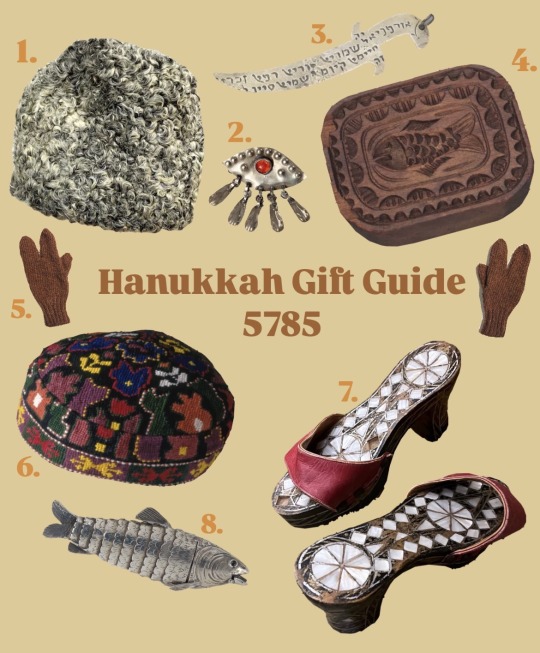
1. Astrakhan lambskin hat, late 19th century, Russian Empire
2. Evil eye amulet, early 20th century, Derbent, Dagestan
3. Amulet engraved with the names of angels, 19th century, Iran
4. Carved wooden pastry stamp, 19th century, Odesa, Ukraine
5. Cloven wool mittens for doing the Kohanic blessing (made by yours truly)
6. Embroidered skullcap, early 20th century, Uzbekistan
7. Mikvah clogs, circa 1900, Egypt
8. Silver spice box shaped like a fish, 19th century
1K notes
·
View notes
Text
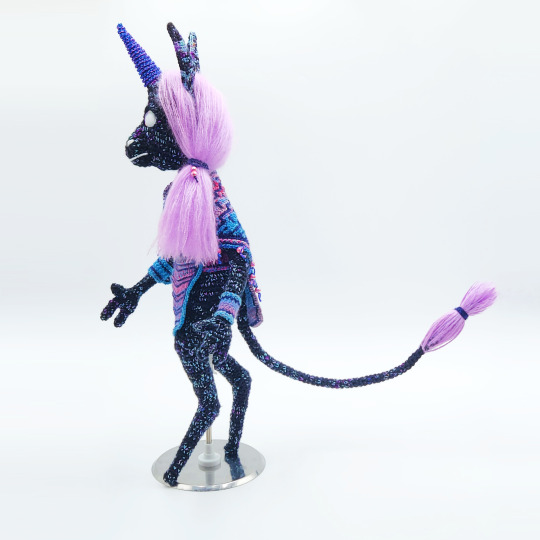


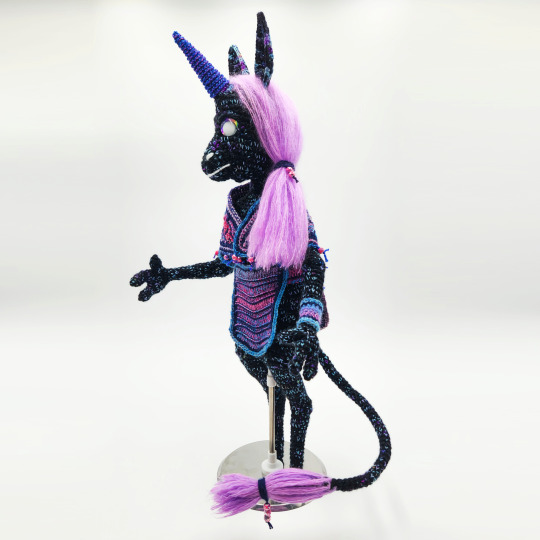



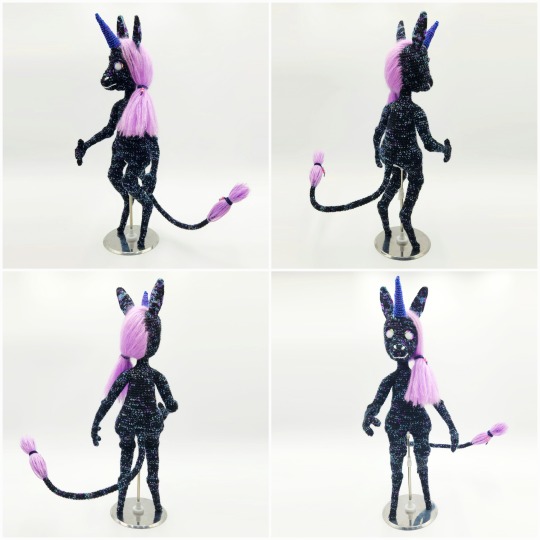
"No sorrow will live in me so long as that joy -- save one. And I thank you for that part, too."
#unicorn#fiber art#crochet#textiles#amigurumi#fantasy#xen makes frens#her name vapor b wave and she uses her cotton candy magic to bring people back from bad/scary trips
2K notes
·
View notes
Text
Something incredibly satisfying about knowing your craft and the confidence that goes with it. Just the casual “yeah I could make that”. Want a band tee? Yeah I can embroider my own with the lyrics I want. Bridesmaid dress too long? Yeah I can hem it. Need new slippers? Yeah I can crochet a pair (and give them bunny ears). And of course it’s not perfect but nothing beats that feeling of being able to craft your own solution with your own two hands
#this was prompted by watching nerdforge on YouTube#which I highly recommend they just made an office with a bed that moves as required because they wanted the space#and the “well we want this so we’re going to make it attitude#I aspire to#due to space and resources I’m stuck with limited textile arts but want to and will learn more#want to also sew my own clothes but see above re space#so doing mending and alterations for now which is still satisfying!!!#plus being able to make all your friends presents#rambles#crochet#embroidery#seeing#questwithambition
3K notes
·
View notes
Text



59" x 69", Pattern is The Taylor Quilt by Kitchen Table Quilting.
A christmas gift for a friend's cousin who hosted me last year and i pulled down the fabric rabbit hole (buttonhole?) during my stay and we've since become stash penpals. A lot of the colors+the backings are fabric they've sent me, it felt really nice to bring all their generosity together into a quilt I could give back to them
#“christmas gift” its march#i wanna make another one of these with a darker bg color#quilt#quilting#quiltblr#quilters of tumblr#sewing#textile art#my stuff
498 notes
·
View notes
Text
Inspired by @rowantarctic, I did an emerald duo bag
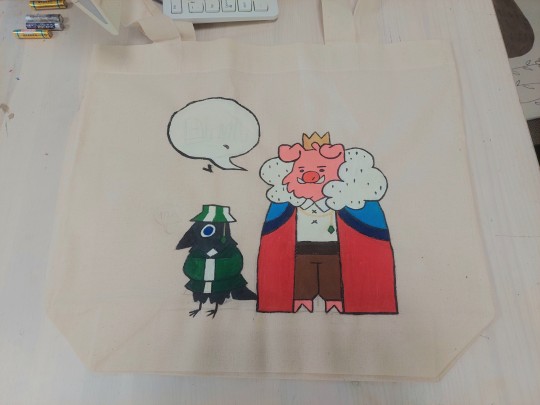
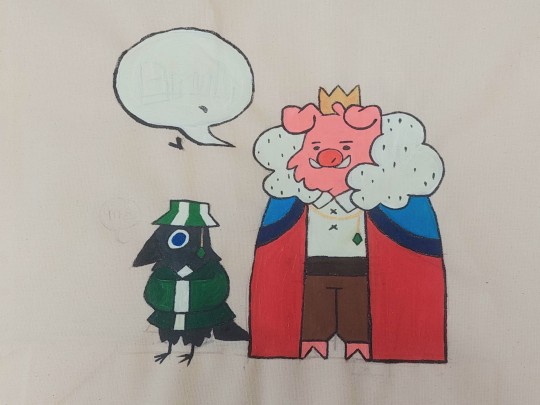
#emerald duo#philza#philza minecraft#technoblade#philza fanart#technoblade fanart#emerald duo fanart#making a clean line with a brush on the textile is so hard#my arms were sweaty#moms spaghetti#insane precision of an alcoholic goose#arts and crafts#artists on tumblr#vicious crafts#vicious art
568 notes
·
View notes
Text

Wrought Iron ✢ Handmade Choker The design was inspired by gothic wrought iron fences. I tea dyed both the lace and cotton twill backing to match the cream needlepoint thread ^^
#I am planning on headdresses with this sort of design but its going to take me a long time to get those done lol#i would like to try making more designs like this though in addition to the text needlepoints ^^ i think it turned out quite cute#also ignore the weirdest coord ever in the product photos lol ive been so tired and i wanted to pair it with that vm dress but#couldnt find a matching blouse with a high enough collar lmaaooo#and i would prefer to keep the chokers and whatnot off of my skin as much as possible since theyre being sold#anyways long explanation for nothing. i think this choker turned out very cute#textile
414 notes
·
View notes
Text
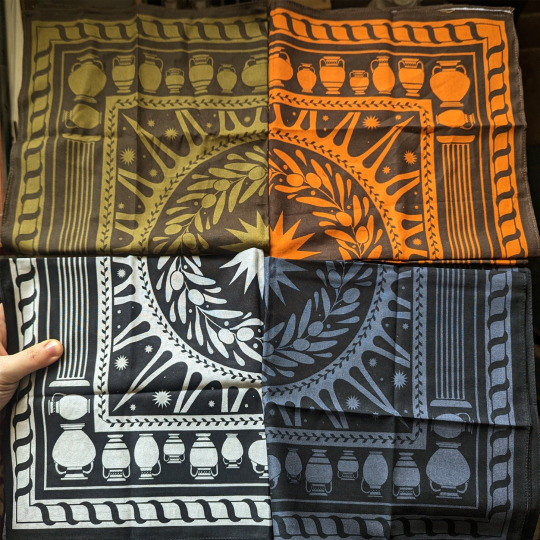


Hi friends, bandanas are here : )
#I also added new stickers and prints but.. i will post about that separately later i suppose#but.. this is my first time making anything textile.. so i hope it does okay#ty everyone#goodnight
1K notes
·
View notes
Text
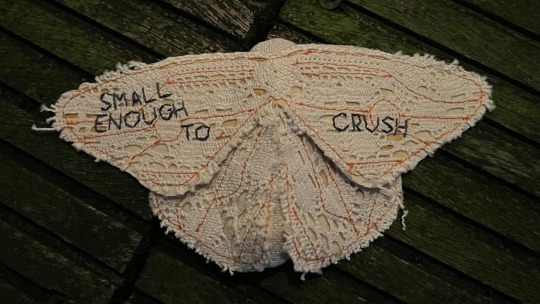
no one knows how much it hurts when a little thing dies. when a bug runs its fate is already decided. what made him know he could get away with hurting me? he made me small enough to forget i was ever a person. i forgot and forgot under his boot.
—insp by this post from @sweatermuppet
#the bottom layer is rust dyed! i had extra from doing that its so fun. also making a moth wing top rn but the pattern is driving me insane#and illustrating and drawing for class#so im picking up the pace on soft sculptures again to relieve stress lol#my headpieces also have moths on them! those are closer to done im excited#mine#chiara’s art tag#art#bugs#moths#soft sculpture#textiles#fiber arts#fiber crafts#sewing#insects
2K notes
·
View notes
Text

Made a new piece! Both the weave structure (overshot) and the color work design (housetop) are commonly used to make bedspreads. Bedspread x 2.
239 notes
·
View notes
Text
My first yarn wig will always have a special place in my heart 🥰
#crochet#artist#crocheting#fiber art#yarn crafts#yarn#fiber artist#fiber crafts#cosplay#crochet cosplay#my crochet#my cosplay#my art#marie antoinette#historical fashion#crochet wig#wig making#wig#yarn ideas#crochet inspiration#cosplaying#cosplayer#rococo#textile art#fibre artist#fibre arts#craftblr#yarnblr#yarn art#artwork
2K notes
·
View notes
Text
Reblog for a bigger sample size
#hand embroidery#cross stitch#craft poll#Intermittent Stitcher Poll#fibrecraft#textile art#fibre art#knitting#crochet#quilting#lace making#bobbin lace
695 notes
·
View notes
Text
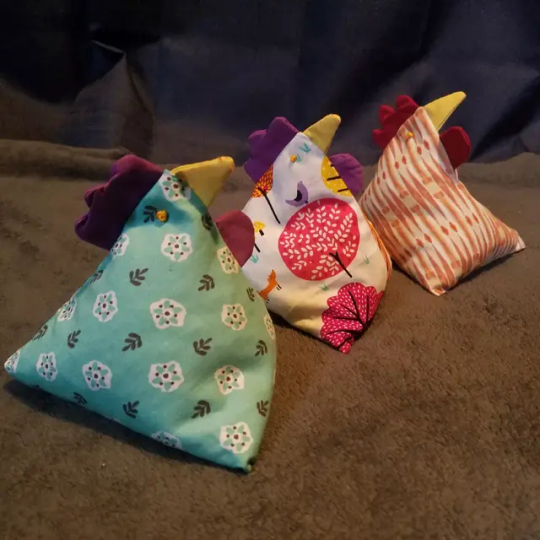
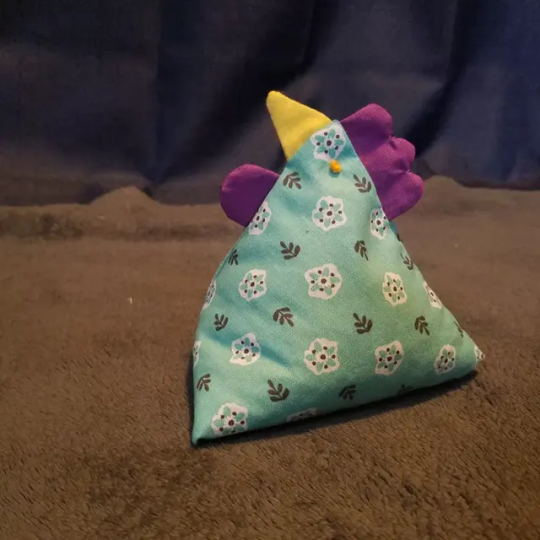

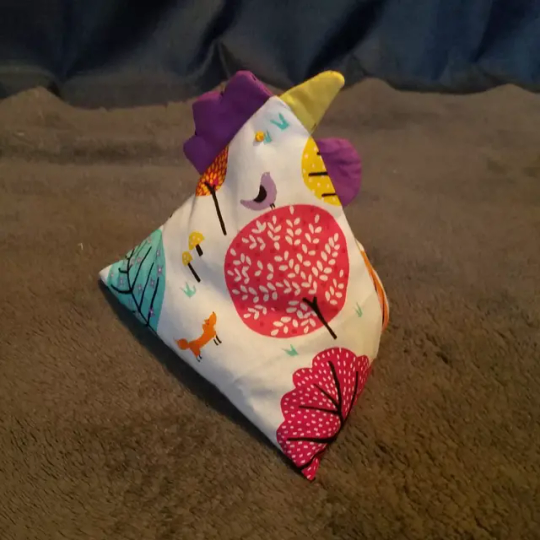
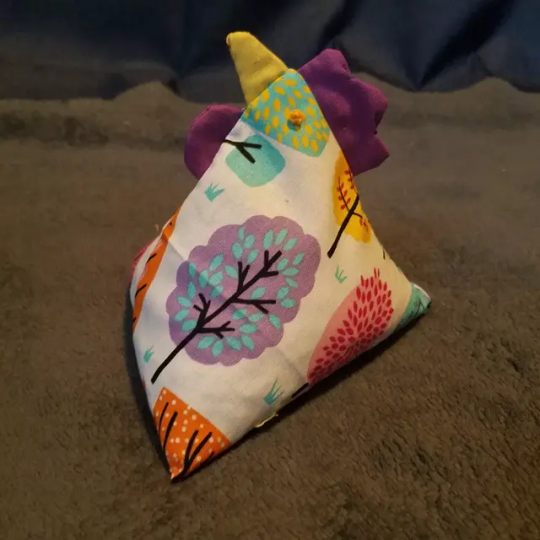

Forgot to post these simple little chicken hacky sacks/heat packs i made for my siblings for christmas. 100% cotton and filled with sunflower seeds (the chickens did NOT appreciate me borrowing from their stash but i was out of rice) so they can be heated up for hand warmers or to ease aches and pains
(or for balancing it on your head i guess)

#brother why#chickens#tiny fluffy dinosaurs#the BEST animals#chickenblr#sewing#hacky sacks#they are so easy to make#maybe I'll make a tutorial if i make some more#arts and crafts#textiles#makenna made a thing
1K notes
·
View notes
Text
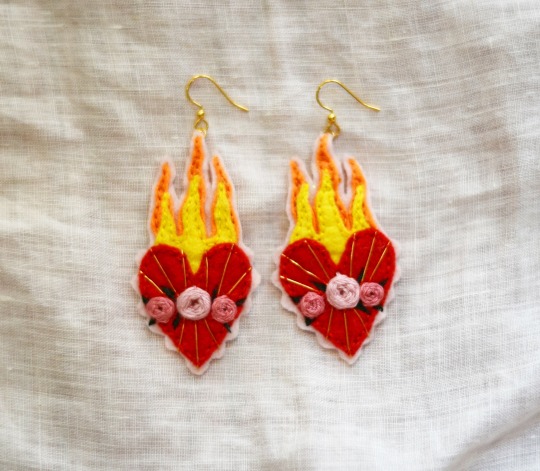

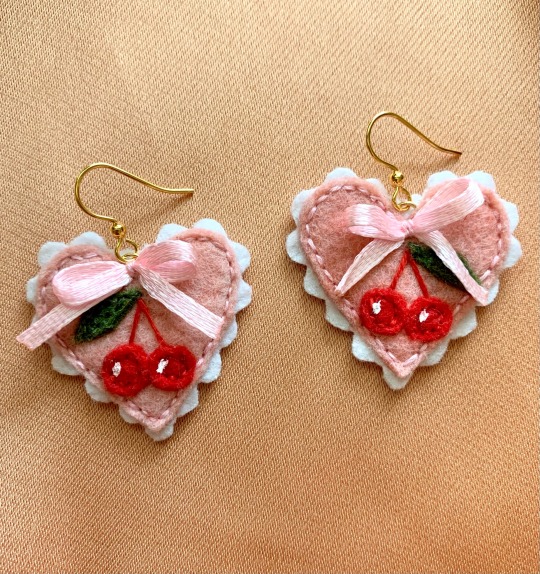
earrings i’ve made this year ❤️🍒
hand embroidery on felt with czech glass beads & gold plated hardware ✨
etsy
#i haven’t made earrings in months i should make more soon#mine#my art#art#textile art#fiber art#artists on tumblr#embroidery#hand embroidery#whimsigoth#slow fashion#jewelry#trinkets#hearts#cherries#lovecore#heartcore#heart aesthetic#earrings#fashion#pink#pink aesthetic#sacred heart
233 notes
·
View notes